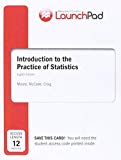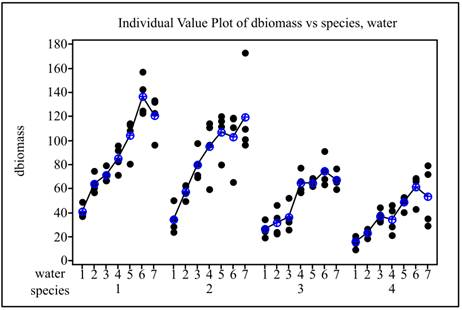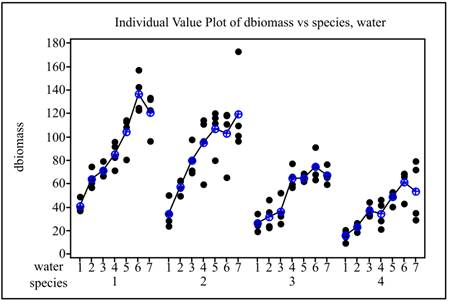
Concept explainers
(a)
To find: The means for each species by water combination and plot these means.
(a)
Answer to Problem 47E
Solution: For Fresh biomass, the first three means for Species-1 are 109.1, 165.1, and 168.82. The first three means for Species-2 are 116.4, 156.8, and 254.88. The first three means for Species-3 are 55.60, 78.9, and 90.3. The first three means for Species-4 are 35.13, 58.33, and 94.54.
For Dry biomass, the first three means for Species-1 are 40.56, 63.86, and 71.00. The first three means for Species-2 are 34.50, 57.36, and 79.60. The first three means for Species-3 are 26.25, 31.87, and 36.24. The first three means for Species-4 are 15.53, 23.29, and 37.05.
Explanation of Solution
Calculation: To obtain the means for the response variable Fresh biomass, Minitab is used. The steps to be followed are:
Step 1: Go to the Minitab worksheet.
Step 2: Go to Stat
Step 3: Enter the variable ‘Fresh biomass’ in the ‘Variable’ option.
Step 4: Enter the variables ‘Species and Water’ in the ‘By Variable’ option.
Step 5: Go to statistics and select ‘Mean.
Step 6: Go to graph and select Individual value plot’.
Step 7: Click Ok.
The obtained result shows the means for each species by water level. Here, few of them are given: The first three means for Species-1 are 109.1, 165.1, and 168.82. The first three means for Species-2 are 116.4, 156.8, and 254.88. The first three means for species-3 are 55.60, 78.9, and 90.3. The first three means for Species-4 are 35.13, 58.33, and 94.54. The obtained graph is given below:

To obtain the means for the response variable Dry biomass, Minitab is used. The steps to be followed are:
Step 1: Go to the Minitab worksheet.
Step 2: Go to Stat
Step 3: Enter the variable ‘Dry biomass’ in the ‘Variable’ option.
Step 4: Enter the variables ‘Species and Water’ in the ‘By Variable’ option.
Step 5: Go to statistics and select ‘Mean.
Step 6: Go to graph and select Individual value plot’.
Step 7: Click Ok.
The obtained result shows the means for each species by water level. Here, few of them are given: The first three means for Species-1 are 40.56, 63.86, and 71.00. The first three means for Species-2 are 34.50, 57.36, and 79.60. The first three means for species-3 are 26.25, 31.87, and 36.24. The first three means for Species-4 are 15.53, 23.29, and 37.05. The obtained graph is given below:

(b)
To find: The standard deviation for each species by water combination and plot these means.
(b)
Answer to Problem 47E
Solution: For Fresh biomass, the first three standard deviations for Species-1 are 20.9, 29.1, and 18.87. The first three standard deviations for Species-2 are 29.3, 46.9, and 13.94. The first three standard deviations for Species-3 are 13.20, 29.5, and 28.3. The first three standard deviations for Species-4 are 11.63, 6.79, and 13.93.
For Dry biomass, the first three standard deviations for Species-1 are 5.58, 7.51, and 6.03. The first three standard deviations for Species-2 are 11.61, 6.15, and 13.09. The first three standard deviations for Species-3 are 6.43, 11.32, and 11.27. The first three standard deviations for Species-4 are 4.89, 3.33, and 5.19.
Explanation of Solution
Calculation: To obtain the means for Fresh biomass, Minitab is used. The steps to be followed are:
Step 1: Go to the Minitab worksheet.
Step 2: Go to Stat
Step 3: Enter the variable ‘Fresh biomass’ in the ‘Variable’ option.
Step 4: Enter the variables ‘Species and Water’ in the ‘By Variable’ option.
Step 5: Go to statistics and select ‘Standard deviation’.
Step 6: Click Ok.
The obtained result shows the means for each species by water level. Here, few of them are given: The first three standard deviations for Species-1 are 20.9, 29.1, and 18.87. The first three standard deviations for Species-2 are 29.3, 46.9, and 13.94. The first three standard deviations for species-3 are 13.20, 29.5, and 28.3. The first three standard deviations for Species-4 are 11.63, 6.79, and 13.93.
To obtain the means for Dry biomass, Minitab is used. The steps to be followed are:
Step 1: Go to the Minitab worksheet.
Step 2: Go to Stat
Step 3: Enter the variable ‘Dry biomass’ in the ‘Variable’ option.
Step 4: Enter the variables ‘Species and Water’ in the ‘By Variable’ option.
Step 5: Go to statistics and select ‘Standard deviation’.
Step 6: Click Ok.
The obtained result shows the means for each species by water level. Here, few of them are given: The first three standard deviations for Species-1 are 5.58, 7.51, and 6.03. The first three standard deviations for Species-2 are 11.61, 6.15, and 13.09. The first three standard deviations for species-3 are 6.43, 11.32, and 11.27. The first three standard deviations for Species-4 are 4.89, 3.33, and 5.19
The highest SD from the Fresh biomass data is 108.01 and the lowest SD is 6.79. Thus,
The highest SD from the Dry biomass data is 35.76 and the lowest SD is 3.12. Thus,
Hence, it is reasonable to pool the standard deviation.
(c)
To test: A two-way ANOVA for Fresh biomass and Dry biomass
(c)
Answer to Problem 47E
Solution: A two-way ANOVA for Fresh biomass is provided below:
Source of Variation |
Degree of freedom |
Sum of squares |
Mean sum of squares |
F- value |
P- value |
Species |
3 |
458295 |
152765 |
81.45 |
0.000 |
Water |
6 |
491948 |
81991 |
43.71 |
0.000 |
Interaction |
18 |
60334 |
3352 |
1.79 |
0.040 |
Error |
84 |
157551 |
1876 |
||
Total |
111 |
1168129 |
A two-way ANOVA for Dry biomass is provided below:
Source of Variation |
Degree of freedom |
Sum of squares |
Mean sum of squares |
F- value |
P- value |
Species |
3 |
50524 |
16841.3 |
79.93 |
0.000 |
Water |
6 |
56624 |
9437.3 |
44.79 |
0.000 |
Interaction |
18 |
8419 |
467.7 |
2.22 |
0.008 |
Error |
84 |
17698 |
219.7 |
||
Total |
111 |
133265 |
Explanation of Solution
Calculation: To perform a Two-way ANOVA for Fresh biomass, Minitab is used. The steps to be followed are:
Step 1: Go to the Minitab worksheet.
Step 2: Go to Stat
Step 3: Enter the variable ‘Fresh biomass’ in the ‘Response’ option.
Step 4: Enter the variables ‘Species’ in the ‘Row Factor and ‘Water’ in the Column Factor’.
Step 5: Click Ok.
The obtained results are provided below:
Source of Variation |
Degree of freedom |
Sum of squares |
Mean sum of squares |
F- value |
P- value |
Species |
3 |
458295 |
152765 |
81.45 |
0.000 |
Water |
6 |
491948 |
81991 |
43.71 |
0.000 |
Interaction |
18 |
60334 |
3352 |
1.79 |
0.040 |
Error |
84 |
157551 |
1876 |
||
Total |
111 |
1168129 |
To perform a Two-way ANOVA for Dry biomass, Minitab is used. The steps to be followed are:
Step 1: Go to the Minitab worksheet.
Step 2: Go to Stat
Step 3: Enter the variable ‘Dry biomass’ in the ‘Response’ option.
Step 4: Enter the variables ‘Species’ in the ‘Row Factor and ‘Water’ in the Column Factor’.
Step 5: Click Ok.
The obtained results are provided below:
Source of Variation |
Degree of freedom |
Sum of squares |
Mean sum of squares |
F- value |
P- value |
Species |
3 |
50524 |
16841.3 |
79.93 |
0.000 |
Water |
6 |
56624 |
9437.3 |
44.79 |
0.000 |
Interaction |
18 |
8419 |
467.7 |
2.22 |
0.008 |
Error |
84 |
17698 |
219.7 |
||
Total |
111 |
133265 |
Conclusion: From ANOVA table above, for both Fresh biomass and Dry biomass, main effects and interaction are significant. The interaction for Fresh biomass and Dry biomass has the P-value 0.04 and 0.008, respectively.
Want to see more full solutions like this?
Chapter 13 Solutions
LaunchPad for Moore's Introduction to the Practice of Statistics (12 month access)
- Question 1. Your manager asks you to explain why the Black-Scholes model may be inappro- priate for pricing options in practice. Give one reason that would substantiate this claim? Question 2. We consider stock #1 and stock #2 in the model of Problem 2. Your manager asks you to pick only one of them to invest in based on the model provided. Which one do you choose and why ? Question 3. Let (St) to be an asset modeled by the Black-Scholes SDE. Let Ft be the price at time t of a European put with maturity T and strike price K. Then, the discounted option price process (ert Ft) t20 is a martingale. True or False? (Explain your answer.) Question 4. You are considering pricing an American put option using a Black-Scholes model for the underlying stock. An explicit formula for the price doesn't exist. In just a few words (no more than 2 sentences), explain how you would proceed to price it. Question 5. We model a short rate with a Ho-Lee model drt = ln(1+t) dt +2dWt. Then the interest rate…arrow_forwardIn this problem, we consider a Brownian motion (W+) t≥0. We consider a stock model (St)t>0 given (under the measure P) by d.St 0.03 St dt + 0.2 St dwt, with So 2. We assume that the interest rate is r = 0.06. The purpose of this problem is to price an option on this stock (which we name cubic put). This option is European-type, with maturity 3 months (i.e. T = 0.25 years), and payoff given by F = (8-5)+ (a) Write the Stochastic Differential Equation satisfied by (St) under the risk-neutral measure Q. (You don't need to prove it, simply give the answer.) (b) Give the price of a regular European put on (St) with maturity 3 months and strike K = 2. (c) Let X = S. Find the Stochastic Differential Equation satisfied by the process (Xt) under the measure Q. (d) Find an explicit expression for X₁ = S3 under measure Q. (e) Using the results above, find the price of the cubic put option mentioned above. (f) Is the price in (e) the same as in question (b)? (Explain why.)arrow_forwardThe managing director of a consulting group has the accompanying monthly data on total overhead costs and professional labor hours to bill to clients. Complete parts a through c. Question content area bottom Part 1 a. Develop a simple linear regression model between billable hours and overhead costs. Overhead Costsequals=212495.2212495.2plus+left parenthesis 42.4857 right parenthesis42.485742.4857times×Billable Hours (Round the constant to one decimal place as needed. Round the coefficient to four decimal places as needed. Do not include the $ symbol in your answers.) Part 2 b. Interpret the coefficients of your regression model. Specifically, what does the fixed component of the model mean to the consulting firm? Interpret the fixed term, b 0b0, if appropriate. Choose the correct answer below. A. The value of b 0b0 is the predicted billable hours for an overhead cost of 0 dollars. B. It is not appropriate to interpret b 0b0, because its value…arrow_forward
- Using the accompanying Home Market Value data and associated regression line, Market ValueMarket Valueequals=$28,416+$37.066×Square Feet, compute the errors associated with each observation using the formula e Subscript ieiequals=Upper Y Subscript iYiminus−ModifyingAbove Upper Y with caret Subscript iYi and construct a frequency distribution and histogram. LOADING... Click the icon to view the Home Market Value data. Question content area bottom Part 1 Construct a frequency distribution of the errors, e Subscript iei. (Type whole numbers.) Error Frequency minus−15 comma 00015,000less than< e Subscript iei less than or equals≤minus−10 comma 00010,000 0 minus−10 comma 00010,000less than< e Subscript iei less than or equals≤minus−50005000 5 minus−50005000less than< e Subscript iei less than or equals≤0 21 0less than< e Subscript iei less than or equals≤50005000 9…arrow_forwardThe managing director of a consulting group has the accompanying monthly data on total overhead costs and professional labor hours to bill to clients. Complete parts a through c Overhead Costs Billable Hours345000 3000385000 4000410000 5000462000 6000530000 7000545000 8000arrow_forwardUsing the accompanying Home Market Value data and associated regression line, Market ValueMarket Valueequals=$28,416plus+$37.066×Square Feet, compute the errors associated with each observation using the formula e Subscript ieiequals=Upper Y Subscript iYiminus−ModifyingAbove Upper Y with caret Subscript iYi and construct a frequency distribution and histogram. Square Feet Market Value1813 911001916 1043001842 934001814 909001836 1020002030 1085001731 877001852 960001793 893001665 884001852 1009001619 967001690 876002370 1139002373 1131001666 875002122 1161001619 946001729 863001667 871001522 833001484 798001589 814001600 871001484 825001483 787001522 877001703 942001485 820001468 881001519 882001518 885001483 765001522 844001668 909001587 810001782 912001483 812001519 1007001522 872001684 966001581 86200arrow_forward
- For a binary asymmetric channel with Py|X(0|1) = 0.1 and Py|X(1|0) = 0.2; PX(0) = 0.4 isthe probability of a bit of “0” being transmitted. X is the transmitted digit, and Y is the received digit.a. Find the values of Py(0) and Py(1).b. What is the probability that only 0s will be received for a sequence of 10 digits transmitted?c. What is the probability that 8 1s and 2 0s will be received for the same sequence of 10 digits?d. What is the probability that at least 5 0s will be received for the same sequence of 10 digits?arrow_forwardV2 360 Step down + I₁ = I2 10KVA 120V 10KVA 1₂ = 360-120 or 2nd Ratio's V₂ m 120 Ratio= 360 √2 H I2 I, + I2 120arrow_forwardQ2. [20 points] An amplitude X of a Gaussian signal x(t) has a mean value of 2 and an RMS value of √(10), i.e. square root of 10. Determine the PDF of x(t).arrow_forward
 MATLAB: An Introduction with ApplicationsStatisticsISBN:9781119256830Author:Amos GilatPublisher:John Wiley & Sons Inc
MATLAB: An Introduction with ApplicationsStatisticsISBN:9781119256830Author:Amos GilatPublisher:John Wiley & Sons Inc Probability and Statistics for Engineering and th...StatisticsISBN:9781305251809Author:Jay L. DevorePublisher:Cengage Learning
Probability and Statistics for Engineering and th...StatisticsISBN:9781305251809Author:Jay L. DevorePublisher:Cengage Learning Statistics for The Behavioral Sciences (MindTap C...StatisticsISBN:9781305504912Author:Frederick J Gravetter, Larry B. WallnauPublisher:Cengage Learning
Statistics for The Behavioral Sciences (MindTap C...StatisticsISBN:9781305504912Author:Frederick J Gravetter, Larry B. WallnauPublisher:Cengage Learning Elementary Statistics: Picturing the World (7th E...StatisticsISBN:9780134683416Author:Ron Larson, Betsy FarberPublisher:PEARSON
Elementary Statistics: Picturing the World (7th E...StatisticsISBN:9780134683416Author:Ron Larson, Betsy FarberPublisher:PEARSON The Basic Practice of StatisticsStatisticsISBN:9781319042578Author:David S. Moore, William I. Notz, Michael A. FlignerPublisher:W. H. Freeman
The Basic Practice of StatisticsStatisticsISBN:9781319042578Author:David S. Moore, William I. Notz, Michael A. FlignerPublisher:W. H. Freeman Introduction to the Practice of StatisticsStatisticsISBN:9781319013387Author:David S. Moore, George P. McCabe, Bruce A. CraigPublisher:W. H. Freeman
Introduction to the Practice of StatisticsStatisticsISBN:9781319013387Author:David S. Moore, George P. McCabe, Bruce A. CraigPublisher:W. H. Freeman





